How to Get Your Website on Page 1 of Google 


If part of your digital marketing strategy is looking to increase the traffic to your website, Google is where it’s at. The truth is that there are more than 3.5 billion Google searches every day.
Google isn’t going anywhere. You need to get on board or risk getting left behind. But SEO isn’t a fast game. You can’t flick a switch and rank on the first page overnight. SEO is a long-term strategy that will deliver results. In fact, almost 60% of the pages that rank on the first page of Google are at least three years old. Patience is key.
There’s are also other ways to get noticed on page 1, depending on your website and budget. You’ve probably seen the top coveted spots at the page reserved for Google Ads.
Getting your website on page 1 is an often misunderstood art. And if you don’t know the steps to take to get results I can almost guarantee that you are throwing money and time at something that will not help your business. So, in this article, I am going to give you actionable steps that you can implement to rank higher on Google. I am going to cover:
- Why the first page of Google is important.
- How improving your website ranking will benefit your business.
- How to use SEO and Google Ads to get your website on the first page of Google.
- How to get a Google featured snippet.
- How to develop a local SEO strategy.
There’s a lot to cover, so let’s get into it.
Why the first page of Google is important
Anything that isn’t on the first page is Google wasteland. And that’s putting it nicely.
75% of searchers will only ever click on results on the first page. They don’t even make it to the second page. What’s even more telling about the power of the first page is that the result in the first position on Google gets approximately 32% of all clicks. That’s a pretty good place to be in.
Even the second position captures almost 25% of the clicks and just over 6% for the sixth position. If you’re on the second page of the search results, you can only expect a CTR of about 0.78%.
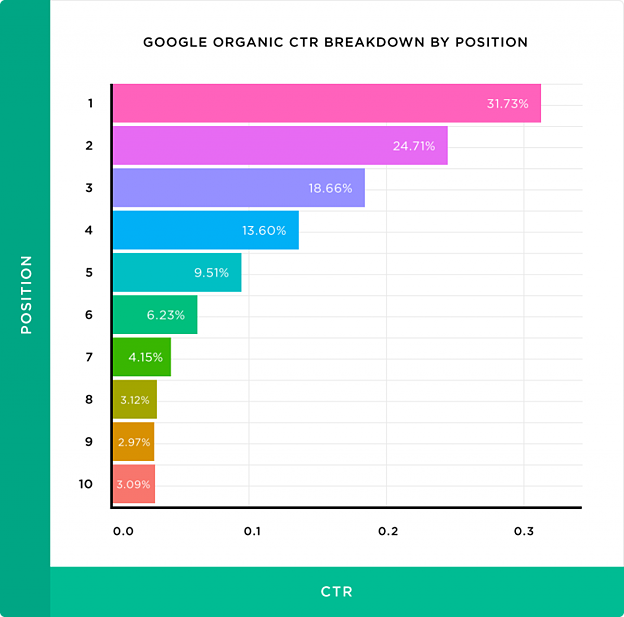
Image source: Backlinko
Of the billions of web pages that Google has indexed, nearly 91% of them actually receive no traffic from Google. Ouch!
Those numbers speak for themselves. If you don’t rank on the first page, the chances are that you will never be found by your potential customers. There’s a joke we SEOs tell and it asks, “Where do you hide something that you don’t want people to find?”
The answer? “On the second page of Google.”
The further down the search engine results you appear. Whether it’s page two or page ten, the less chance you have of increasing your traffic and sales.
The other thing you should know is that your competitors are already ranking on Google. Go on, type one of your keywords into Google and see who shows up.
The longer you wait to implement an SEO strategy, the longer it will take you to get to those prized top positions. And it’s not easy to make up for that lost time.
The good news is that you don’t need massive marketing budgets to break through to the first page. When you get there, you’ll see what all the fuss is about.
How does first-page ranking benefit your business?
From the statistics I’ve already given you, you’ve probably realised that a first-page ranking is a good thing for your business. And it’s not just increased click through rates. It’s all the benefits those increased click-through rates bring.
Not to mention some other really cool things that can happen when you rank on the first page. Like what, you ask? Let me give you a little rundown.
More visibility
This is a no-brainer, right? If you are on the first page of Google for particular keywords then you are more visible to the people who are searching for that thing.
Improved visibility also has an amazing flow-on effect in that the more people see your brand and website in the search results (remember, the vast majority of them aren’t even clicking through to the second page) then the greater their awareness of your brand.
Better engagement, traffic and leads
If you are buried on page two – or worse! – of the search engine results, you will get nothing. Well, considering the stats, what you will get is about as useless as nothing.
But, on the first page, everything changes.
When you rank on the first page for keywords with strong buyer intent, you will likely see increased engagement. Your organic traffic will increase and you will have more leads coming through your virtual doors. Getting to a top-ranking position in the search engines matters.
68% of online experiences start with someone searching within a search engine. And 39% of shoppers are influenced by a relevant search.
People turn to Google for answers. They turn to Google when they want products. If you are there, on the first page of the SERPs for your keywords, you have more chance of them finding you. And that’s when all this good stuff starts to happen.
Greater authority and trust
Back in the early days of SEO, you could produce spammy content, stuffed with keywords and still rank in the first position. But, over the years, Google has refined the algorithm so that the ranking factors consider the quality of the content on a website.
Google searchers know that. They know that when they search for something on Google, the top SERP will likely give them the answer they need. That’s why so few of them go past the first page of the search engines.
What that means for businesses that rank on the first page is increased industry authority and the ability to establish trust with your website visitors before they even click through to your website. They know that Google has done the hard work to weed out the spam and low-quality pages.
How do you use search engine optimisation (SEO) to get on the first page of Google?
There is no magic formula to get on the first page.
Instead, there is a process you can follow which will see your rankings and organic traffic start to rise.
This is the process we use with our clients to get results. And it will get results for you too.
1. Choose a keyword
Keyword research is the foundation of your SEO strategy. You could take a guess at what people are searching for to find you… but why would you guess when you have data at your fingertips that can tell you the exact search terms people are using.
Whether you use a tool like Google Keyword Planner, SEMrush, Google Search Console or one of the many other keyword tools, the process is the same. Ideally, you are looking for niche, long-tail keywords that are tightly linked to buyer intent. These are the keywords you want to rank for in the SERPs.
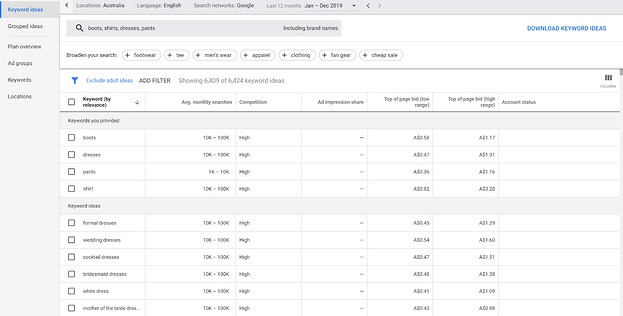
For example, if you sell widgets, ranking for the term “widgets” in the SERP is likely not going to be as valuable for you as a term like “where to buy widgets in Australia”.
To do this, you will need to understand your buyer personas and be prepared to spend some time digging into the keyword tools to uncover your gold.
2. Check the competition
The competition for your keywords will vary depending on your industry. You will also find that competition is more fierce for shorter rather than long-tail keywords.
This is where SEO competitor analysis comes in. You need to know who your competitors are for a particular keyword, and what they are doing so that you can create content that will push you past them in the organic search results.
You might already have a good feel for your competitors and what you need to do to outrank them. But it’s important that you don’t skip this step or you won’t be working with the full picture.
There are various tools you can use to identify your competitors, such as Ahrefs or Moz. This can even be a good place to find keywords as you can uncover the terms your competitors are ranking for. But you can also use Google to help you. Simply type your target keyword into the Google search bar (quick tip: use incognito mode) and see what content comes up.
In this example on a search for used cars in Australia, you can see that the top two organic results are for the same business.
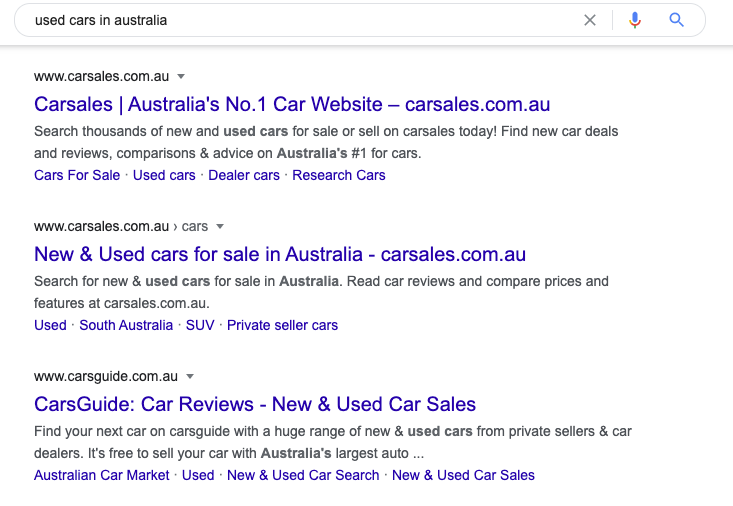
Once you understand your competitors and what they are doing, you have a better chance of outranking them.
3. Map keyword to an existing page or create a new one
One thing that many people don’t understand is that Google doesn’t rank websites. Instead, it ranks individual web pages. The great thing about this is that you have limitless potential for how many keywords you can rank for in the organic SERP listings. Obviously, you only want to rank higher for ones relevant to your business, but you aren’t limited in any way as to how many.
As long as the keyword is relevant and relates to some type of intent – e.g. to make a purchase or an enquiry – then you should consider it as part of your strategy.
Each keyword you are trying to target must have its own page. This could be a new page that you create specifically for this keyword, or you may be able to map the keyword to an existing page.
The type of content you create should be related to the intent of the keyword, for example:
- Blog posts to target keywords with informational intent
- Product or category pages to target keywords with a purchase intent
- Landing pages to target keywords with a service purchase intent
The aim of on-page optimisation and mapping keywords to tailored and targeted content is to give your website visitors exactly what they are looking for in a single click. If you can do that, you are onto the winning strategy.
4. Produce a killer piece of content
Low-quality content will not help you get on the first page of Google. It just isn’t going to happen.
If the Google algorithm gets even a whiff of low-quality content, you will be booted off the first page before you’ve even arrived there.
In the last step, I told you that you need to give your website visitors exactly what they are looking for in a single click. If you write a 100-word article on a topic, it simply isn’t going to cut it. Not when the average length of content that appears on the first page of the Google search results is 1,447 words.
Whatever format you are using, whether it is a review, listicle article, comparison or a product description, you need to speak directly to the intent of the website visitor.
A content audit will give you an idea of what you need to do with your current content to make it first page worthy.
5. Add internal links
While Google indexes individual web pages, in doing so they look at the overall structure of your site and the internal indicators and schema that point to the overall health and relevance of the webpage.
Internal links are a really powerful way to do this.
On your website, you mention the keyword you are trying to rank for should link through to the page for that keyword. If you don’t have any other mentions, look for opportunities to edit existing content to create internal links.
You will probably be surprised at how many opportunities for internal linking you can find.
6. Build backlinks
Backlinks are an important element in how you get on the first page of Google. Google has confirmed that this is part of the algorithm… and when Google speaks, we listen.
Link building is a long-term strategy that will pay off over time as you grow the number of backlinks to your site.
There is no definitive number of backlinks you need to rank for a keyword. The more competitive a keyword is, the more backlinks you will need to rise up the rankings. A tool like Ahrefs will give you an estimate on the number of backlinks you will need to get a top 10 ranking.
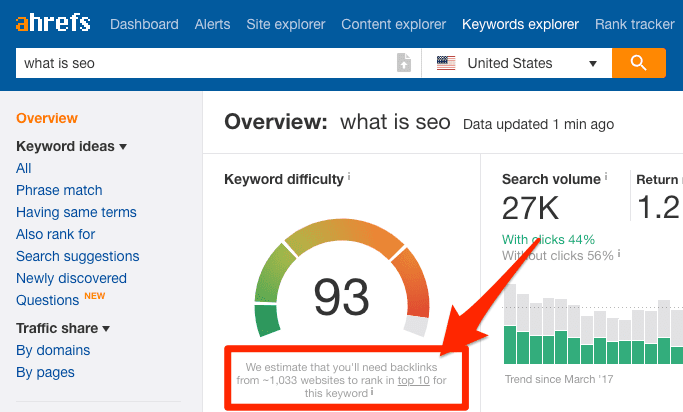
Image source: Ahrefs
When it comes to backlinks, there is one thing you need to remember – quality matters. In fact, quality always matters when it comes to SEO, no matter what you are doing. The best approach is a white hat strategy that focuses on quality.
Quality relates to how good the content that is linking to you is, as well as the relevance to your content. If you write a blog in an attempt to rank for the keyword “how to clean leather shoes” and you have a backlink from an irrelevant page that is about vegan beauty products, it won’t do you any favours in the ranking stakes.
7. Review metrics
Everything I have just told you to do takes time. And not just time in implementing it. It also takes time for the hard work to pay off as you gradually increase your rankings.
But, what you can’t do is follow steps 1-6 and then hope for the best. You need to consistently review the top SEO metrics and make adjustments as required. You need to keep your eye on your conversion rates and CTR as well as your bounce rate and dwell time.
Also regularly check your site health and look at the links to your domain. Within Google Search Console you can also check your performance in the SERP listings and review your progress over time for target keywords.
If something isn’t working and you aren’t seeing an increase in your rankings, look at what the data is telling you and make the adjustments you need to get the results you want.
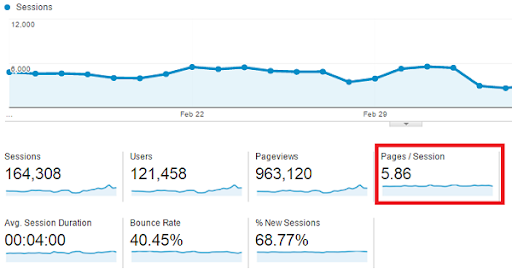
Image source: Google Analytics
8. Repeat
So you’ve optimised one page. But what about all the other pages on your website? And the countless other keywords you could be rank better for?
Systematically work your way through your website and keyword list following each of the steps I’ve listed above. Each time you do it you will get better and better at it. As you start to see results you will build momentum and find yourself on the first page for multiple keywords.
How to use Google Ads to get to the top?
I’ve already told you that SEO is about the long game. But that doesn’t mean you need to wait months and months to get on the first page.
Google Ads can work hand in hand with SEO to increase your traffic and get you on the first page of the SERPs.
A Google Ads campaign will generally take 3 months to mature and 3-12 months to develop a really strong campaign. Compared to SEO which can take 12 months (or longer) just to get on the first page and you can see why combining SEO and Google Ads is a smart approach.
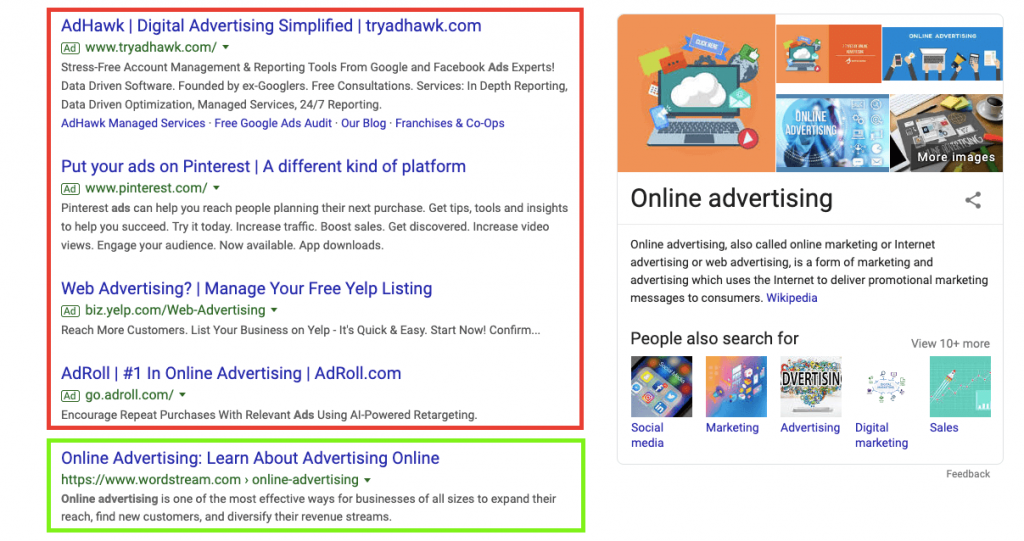
Image source: WordStream
Compared to organic website visitors, those who come via PPC are 50% more likely to purchase something.
To do Google Ads well you need to understand both quality score and CPC. Those are both really meaty subjects so I suggest you read our resources to equip yourself with the knowledge you need to do them well.
What you are going to do is to be strategic with your PPC spend. Look at what your competitors are doing, both for SEO and paid advertising, and then present potential customers with the content most directly related to their intent.
How do you get a Google featured snippet?
12.3% of search queries on Google contain a featured snippet. It’s these rich snippets that are driving a trend that now sees 48% of Google searches resulting in no click at all.
With a featured snippet, the user gets the answer they need to their question so there is no need to click through to learn more.
You probably know what featured snippets look like, but here are a couple of examples.
This one is a featured recipe snippet. Searchers would still need to click through to the website for the method but given the prominence of the result, there is a good chance this website will capture the click.
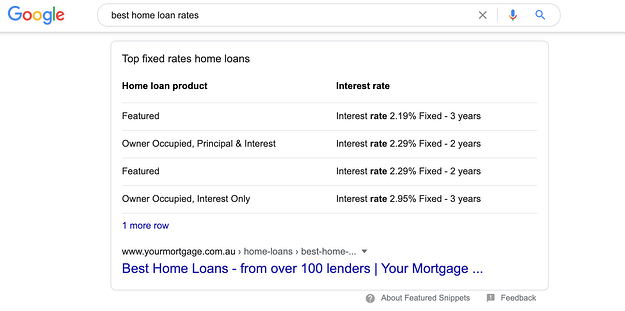
This is another type of featured snippet in a paragraph style that answers a question. If searchers want more information, they can click through to the website.
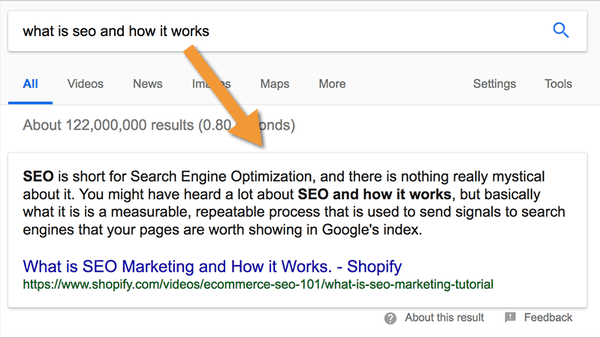
Image source: Search Engine People
So, how do you get yourself one of these featured snippets?
It really comes down to how you structure your content and optimising it for the rich snippet format.
I would suggest reading our complete guide on featured snippets (put together with research by our own R&D) as this will give you everything you need to know. But, at a high level, to optimise for rich snippets you should:
- Use clear headers and bullet lists
- Answer questions fully with a single, condensed, factual and simple paragraph
- Use schema markup
- Add relevant images and video to your content
How to get in the local pack?
Local SEO is incredibly important. It will probably blow your mind to learn that 46% of all searches on Google are for a local business or local service.
If you run a business where location matters, for example, a restaurant or a trade, you should absolutely optimise your Google My Business listing to capture local search opportunities. If you don’t, your competitors will.
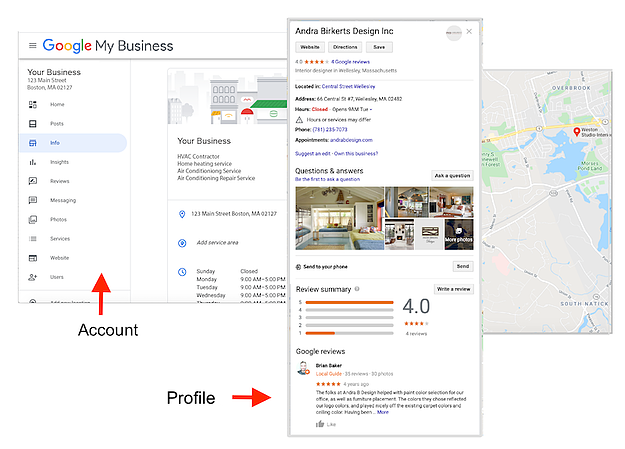
Image source: WordStream
Your Google My Business Listing will give a Google Maps reference as well as other information you add to your profile, such as opening hours and contact details as well as customer reviews.
To optimise for local search and get in the local pack, you’ll first need to create a Google My Business account. This is how you create your listing and ensure your business appears in the Google Maps search results when people search for a local business near their location.
Once you’ve set up your account, make sure you complete every section of your profile and keep the information up to date. Incorrect information is a surefire way to lose trust with a potential customer.
When I say to complete every section of your profile, I also mean adding images and asking your customers to add reviews to your listing. The more complete your profile, the better chance you have of it showing as the featured listing.
Get in front of your audience
Whether you decide to use SEO or SEM, or an integrated campaign which leverages the two, you’ll need a top-notch strategy for how you’ll get your website in front of your audience and ahead of your competitors.
For both short and long term success you need to consider your goals alongside your marketing budget for the highest ROI.
That’s where OMG can help. Get in touch today to discuss how you can get your website front and centre for valuable and profitable searches on Google.









